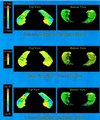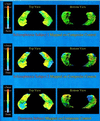Hippocampal morphometry in schizophrenia by high dimensional brain mapping
- PMID: 9736749
- PMCID: PMC21655
- DOI: 10.1073/pnas.95.19.11406
Hippocampal morphometry in schizophrenia by high dimensional brain mapping
Abstract
Theories of the pathophysiology of schizophrenia have implicated the hippocampus, but controversy remains regarding hippocampal abnormalities in patients with schizophrenia. In vivo studies of hippocampal anatomy using high resolution magnetic resonance scanning and manual methods for volumetric measurement have yielded inconclusive results, perhaps because of the normal variability in hippocampal volume and the error involved in manual measurement techniques. To resolve this controversy, high dimensional transformations of a computerized brain template were used to compare hippocampal volumes and shape characteristics in 15 matched pairs of schizophrenia and control subjects. The transformations were derived from principles of general pattern matching and were constrained according to the physical properties of fluids. The analysis and comparison of hippocampal shapes based on these transformations were far superior to the comparison of hippocampal volumes or other global indices of hippocampal anatomy in showing a statistically significant difference between the two groups. In the schizophrenia subjects, hippocampal shape deformations were found to be localized to subregions of the structure that send projections to prefrontal cortex. The results of this study demonstrate that abnormalities of hippocampal anatomy occur in schizophrenia and support current hypotheses that schizophrenia involves a disturbance of hippocampal-prefrontal connections. These results also show that comparisons of neuroanatomical shapes can be more informative than volume comparisons for identifying individuals with neuropsychiatric diseases, such as schizophrenia.
Figures





Similar articles
-
Regional specificity of hippocampal volume reductions in first-episode schizophrenia.Neuroimage. 2004 Apr;21(4):1563-75. doi: 10.1016/j.neuroimage.2003.11.011. Neuroimage. 2004. PMID: 15050580
-
Hippocampal deformities in schizophrenia characterized by high dimensional brain mapping.Am J Psychiatry. 2002 Dec;159(12):2000-6. doi: 10.1176/appi.ajp.159.12.2000. Am J Psychiatry. 2002. PMID: 12450948
-
Three-dimensional hippocampal MR morphometry with high-dimensional transformation of a neuroanatomic atlas.Radiology. 1997 Feb;202(2):504-10. doi: 10.1148/radiology.202.2.9015081. Radiology. 1997. PMID: 9015081
-
Regional deficits in brain volume in schizophrenia: a meta-analysis of voxel-based morphometry studies.Am J Psychiatry. 2005 Dec;162(12):2233-45. doi: 10.1176/appi.ajp.162.12.2233. Am J Psychiatry. 2005. PMID: 16330585 Review.
-
MR-based in vivo hippocampal volumetrics: 1. Review of methodologies currently employed.Mol Psychiatry. 2005 Feb;10(2):147-59. doi: 10.1038/sj.mp.4001580. Mol Psychiatry. 2005. PMID: 15340353 Review.
Cited by
-
Hippocampal Shape Abnormalities Predict Symptom Progression in Neuroleptic-Free Youth at Ultrahigh Risk for Psychosis.Schizophr Bull. 2016 Jan;42(1):161-9. doi: 10.1093/schbul/sbv086. Epub 2015 Jun 25. Schizophr Bull. 2016. PMID: 26113620 Free PMC article.
-
Morphometric analysis of lateral ventricles in schizophrenia and healthy controls regarding genetic and disease-specific factors.Proc Natl Acad Sci U S A. 2005 Mar 29;102(13):4872-7. doi: 10.1073/pnas.0501117102. Epub 2005 Mar 16. Proc Natl Acad Sci U S A. 2005. PMID: 15772166 Free PMC article.
-
Automatic segmentation of the hippocampus for preterm neonates from early-in-life to term-equivalent age.Neuroimage Clin. 2015 Aug 24;9:176-93. doi: 10.1016/j.nicl.2015.07.019. eCollection 2015. Neuroimage Clin. 2015. PMID: 26740912 Free PMC article.
-
Chronic exposure to haloperidol and olanzapine leads to common and divergent shape changes in the rat hippocampus in the absence of grey-matter volume loss.Psychol Med. 2016 Nov;46(15):3081-3093. doi: 10.1017/S0033291716001768. Epub 2016 Aug 12. Psychol Med. 2016. PMID: 27516217 Free PMC article.
-
Can structural or functional changes following traumatic brain injury in the rat predict epileptic outcome?Epilepsia. 2013 Jul;54(7):1240-50. doi: 10.1111/epi.12223. Epub 2013 May 29. Epilepsia. 2013. PMID: 23718645 Free PMC article.
References
-
- Csernansky J G, Murphy G M, Faustman W O. Biol Psychiatry. 1991;30:383–400. - PubMed
-
- Roberts G W. Trends Neurosci. 1990;13:207–211. - PubMed
-
- Saykin A J, Shtasel D L, Gur R E, Kester D B, Mozley L H, Stafiniak P, Gur R C. Arch Gen Psych. 1994;51:124–131. - PubMed
-
- Falkai P, Bogerts B. Eur Arch Psychiatr Neurol Sci. 1986;236:154–161. - PubMed
-
- Jeste D V, Lohr J B. Arch Gen Psychiatry. 1989;46:1019–1024. - PubMed
Publication types
MeSH terms
Grants and funding
LinkOut - more resources
Full Text Sources
Other Literature Sources
Medical

